Although the data of “Travel and Tourism Competitiveness Report. 2015” published recently, Armenia stepped back by 10 compared to 2013, however, our country has a great potential to attract tourists. It’s another question to what extent the government succeeds in raising the interests of the tourists to our country thanks to some of its programs and bring them to Armenia. Indeed, the government spends huge amounts of money for advertising Armenia in the international arena, but last month, the famous TV star Kim Kardashian did our government’s work for several years in a few days. And as to how much this year Kim Kardashian’s fans will be interested in the country of their favorite celebrity’s great grandparents and will come to Armenia to spend money, it will be known some time later.
According to the Travel and Tourism Competitiveness Report, Armenia ranked the 89th among 141 countries engaged in tourism competitiveness. Our country lags behind its neighbors by this index. Georgia ranked the 71st and Azerbaijan – the 84th. In the tourism industry, the Government of Armenia, if desired, can make the rural tourism attractive and competitive. Foreigners like our rural environment, but there are many problems in this industry. Rural tourism in Armenia has just begun, our villages are very interesting for the foreigners, but let’s say, even if the tour operator manages to bring tourists to Armenia, then getting to the village causes great suffering.
In the conversation with “Aravot”, Coordinator of “Sun Child” eco-tour project, Vahagn Vardumyan, based on his years of work experience, says that first of all the damaged roads hamper the development of rural tourism. In addition, Vahagn Vardumyan notes that there are major international tourist websites, where we are not presented by full resources until recently. “In order to ensure quality and quantity, Armenia should be presented in these websites at the state level and competently.” Ecotourism implementing Vahagn Vardumyan also notes that there is, so to speak, a problem of prices in Armenia. Armenia costs expensive for European tourists. If, for example, a German tourist, as said by Vardumyan, can travel to the Swiss mountains spending about 200-300 euros, then for coming here, he will spend up to approximately 3 thousand euros.
Meanwhile, in Vardumyan’s words, foreign tourists complain about the high prices of services in the hotel, even the Armenian hotels are expensive of the European, but still yield to Europeans by quality. “The prices for hotel services in Armenian are inflated.” As for the rural tourism, the Vardumyan notes that although the foreigners are interested in this field of tourism, however, the villagers are not informed and many of them have no idea about how to make what they have into a product and a business, they are not informed about how, for example, to make their house a guesthouse. “Here, they are in major need for the government support. At least, to organize outreach programs on TV and regularly speak about it, because it is a quite complicated task. The villager must understand how to offer his lifestyle and routine to make it a tourism product.”
Despite the mentioned drawbacks, the poor life of our villages and villagers is of interest to foreign tourists, and even though they, as said by Vardumyan, get to the village by ruined roads and barely driving car, but on seeing an old rural house with worn-out aluminum pans and other utensils, they immediately forget the “suffering” of the road. “As soon as they visit a villager’s house and the villager says, “Oh, I’m not ready, my house is not cleaned up, I have not swept the yard, until the villager complains about her house, the tourists grab the camera greedily and go here and there taking photos. It is so interesting for them. Thus, if we view in general, these old houses, the fences made of the old refrigerator doors, this poor condition attracts the tourists”. Foreign tourists are also attracted by the Armenian dried fruits, jam, pastry, other foods of Armenian traditional cuisine and the way they are prepared, but they are mostly attracted by their participation in the preparation.
Vardumyan says that the tourists are involved in the preparation of various dishes in different seasons. “For example, in tasting dried fruits or jam or something else, we are asking the tourists, “Do you want to see how it’s prepared?”, “Would you also like to be involved in the preparation?” They say, yes, and they become extremely happy. There are many tourists, for example, who have not prepared anything on the fire, and when they prepare something with our villagers, it becomes an event for them. This type of events can substitute the bus tours for a whole day or several days that takes the tourists here and there. This is also a very convenient option for the tour operators: everyone is well fed and happy.” The Travel and Tourism Competitiveness Report presents some negative and positive indicators, also mentioning, “However, there are several major challenges that hinder the growth of Armenia’s competitiveness in the tourism industry. These include the general condition of the environment and natural resources and the low level of protection.”
“Aravot” asked the eco-tourism conducting Vahagn Vardumyan as to what extent the mining and the environmental condition hinder the rural tourism. Vardumyan said that Armenia can survive even without exploiting the mines. If the government develops the villages and the infrastructures, the rural tourism will provide a greater benefit than the tailing and the mine. “By exploiting the mine, we become poor, the tailings remain here, but the money and the gold outflow 2-3 times more in a year than the previous year. Now, of course, we do not take the tourists to such places where there are mines and tailings, we manage to evade them so that the tourist would not complain, but they are rapidly growing, I have no idea what will happen then.”
Nelly BABAYAN

























































